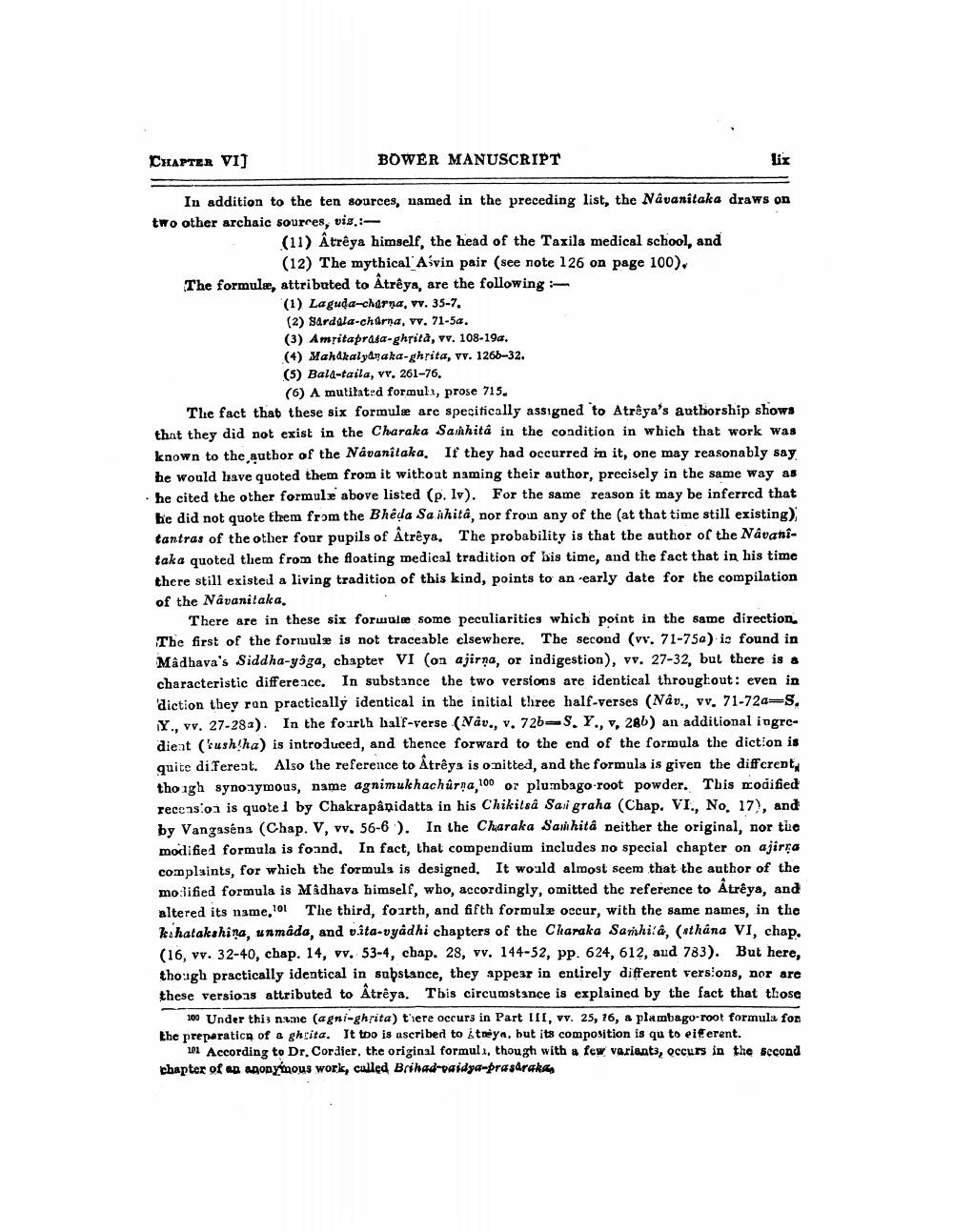________________
CHAPTER VI]
lix
In addition to the ten sources, named in the preceding list, the Nâvanîtaka draws on two other archaic sources, vis,:
(11) Atrêya himself, the head of the Taxila medical school, and (12) The mythical Asvin pair (see note 126 on page 100).
BOWER MANUSCRIPT
The formule, attributed to Atrêya, are the following :
(1) Laguda-charna, vv. 35-7.
(2) Sardala-charna, vv. 71-5a.
(3) Amritaprasa-ghrità, vv. 108-19a.
(4) Mahakalyanaka-ghrita, vv. 1266-32.
(5) Bala-taila, vv. 261-76.
(6) A mutilated formula, prose 715.
The fact that these six formulæ are specifically assigned to Atreya's authorship shows that they did not exist in the Charaka Samhitâ in the condition in which that work was known to the author of the Nâvanîtaka. If they had occurred in it, one may reasonably say he would have quoted them from it without naming their author, precisely in the same way as he cited the other formule above listed (p. lv). For the same reason it may be inferred that he did not quote them from the Bhêda Sanhitâ, nor from any of the (at that time still existing) tantras of the other four pupils of Atrêya. The probability is that the author of the Nâvanîtaka quoted them from the floating medical tradition of his time, and the fact that in his time there still existed a living tradition of this kind, points to an early date for the compilation of the Nâvanitaka,
There are in these six formule some peculiarities which point in the same direction. The first of the formule is not traceable elsewhere. The second (vv. 71-75a) is found in Mâdhava's Siddha-yoga, chapter VI (on ajirna, or indigestion), vv. 27-32, but there is a characteristic difference. In substance the two versions are identical throughout: even in 'diction they ran practically identical in the initial three half-verses (Nâv., vv. 71-72a-S. Y., vv. 27-28a). In the fourth half-verse (Nav., v. 72b-S. Y., v, 286) an additional ingredient (ush!ha) is introduced, and thence forward to the end of the formula the diction is quite diferent. Also the reference to Åtrêya is omitted, and the formula is given the different, though synonymous, name agnimukhachûrna,100 or plumbago root powder. This modified recension is quoted by Chakrapânidatta in his Chikitsâ Sai graha (Chap. VI., No. 17), and by Vangaséna (Chap. V, vv. 56-6 ). In the Charaka Samhitâ neither the original, nor the modified formula is found. In fact, that compendium includes no special chapter on ajirṛa complaints, for which the formula is designed. It would almost seem that the author of the mo:lified formula is Madhava himself, who, accordingly, omitted the reference to Atrêya, and altered its name,101 The third, fourth, and fifth formule occur, with the same names, in the kshatakshina, unmada, and vita-vyadhi chapters of the Charaka Samhitâ, (sthâna VI, chap. (16, vv. 32-40, chap. 14, vv. 53-4, chap. 28, vv. 144-52, pp. 624, 612, aud 783). But here, though practically identical in substance, they appear in entirely different versions, nor are these versions attributed to Atrêya. This circumstance is explained by the fact that those
100 Under this name (agni-ghrita) there occurs in Part III, vv. 25, 26, a plambago-root formula for the preparation of a ghrita. It too is ascribed to itreya, but its composition is qu to eifferent.
101 According to Dr. Cordier, the original formula, though with a few variants, occurs in the second chapter of an anonymous work, called Brihad-vaidya-pras&rakas




